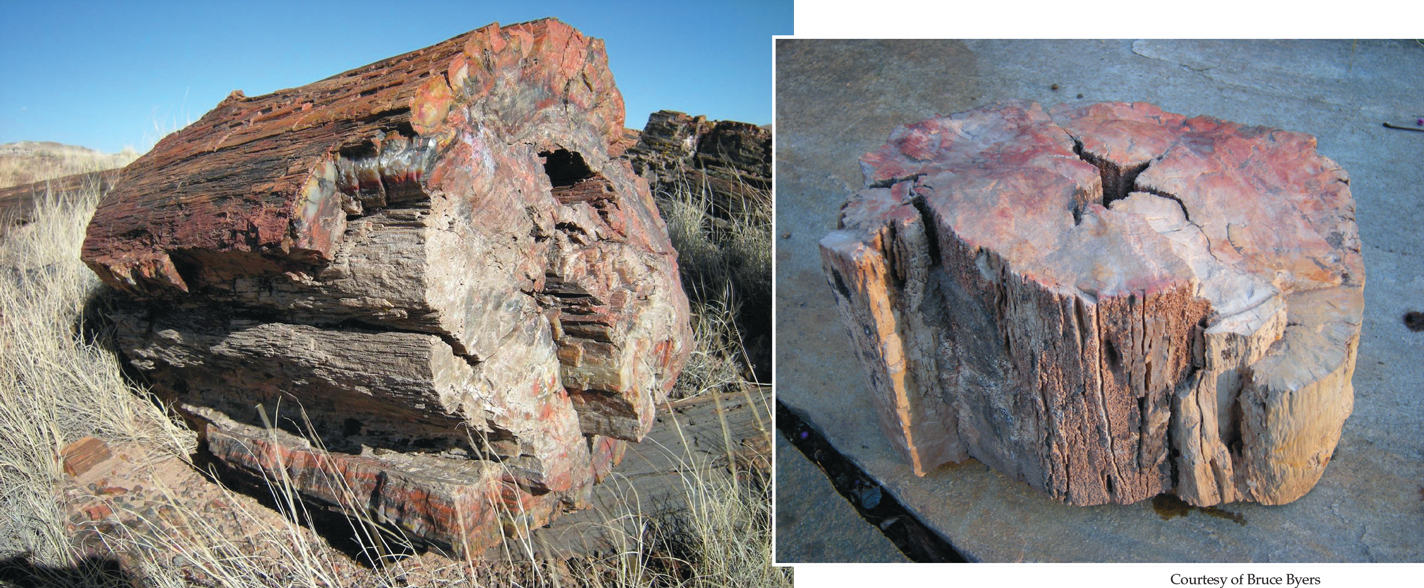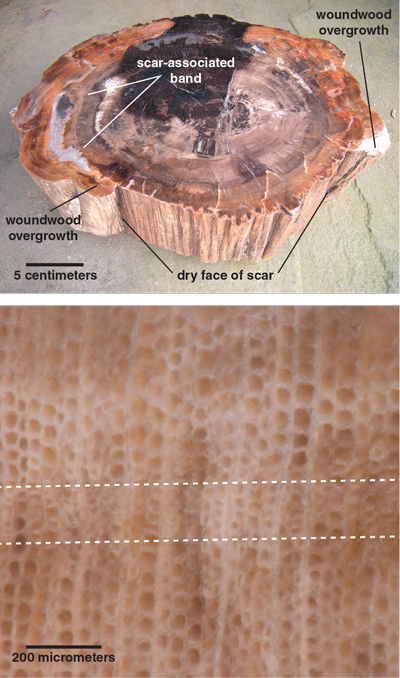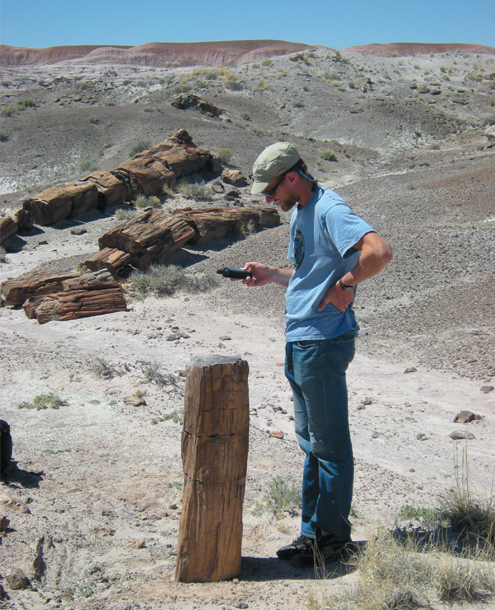Ancient Fire Scars of the Petrified Forest
By Katie L. Burke
Fossilized wood shows that ground fires were reshaping forests and influencing plant evolution more than 200 million years ago.
Fossilized wood shows that ground fires were reshaping forests and influencing plant evolution more than 200 million years ago.

DOI: 10.1511/2021.109.1.6
When Bruce Byers brought home a piece of petrified wood he inherited after his father died in 2012, he didn’t plan to make it the subject of a new area of research. His father had collected the hunk of rock in Bears Ears, Utah, in the 1980s and had long used it as a doorstop. But with the 210-million-year-old fossil newly situated in his home, something niggled at Byers. The ancient log looked to him like it had a fire scar (below, on right), a wood growth formation that happens at the base of a tree in response to a low-intensity ground fire. A patch of live tissue under the bark is killed, and the tree grows scar tissue curled around the wound in response. Byers recalls, “I thought, ‘This is interesting. I’ve never heard of a fossil fire scar.’”

Courtesy of Bruce Byers
Although Byers had never studied ancient wood—he is an environmental consultant and has a PhD in biology—he had worked with researchers studying fire scars on modern wood in the 1980s after he had finished his graduate work. To settle his curiosity about whether anyone had found a fossil fire scar on a specimen like his dad’s, Byers started searching for research or coverage about the topic—but he didn’t turn up anything. So he called the Petrified Forest National Park and eventually got the chief paleontologist on the phone, who referred Byers to Sidney Ash, a paleobotanist who had studied the park’s ancient wood for more than 30 years and who was then a retired professor at the University of New Mexico, Albuquerque (Ash passed away last year). When Byers reached Ash, the latter responded, “What’s a fire scar?” Byers recalls, “I realized that there was this disconnect between modern fire ecologists and the paleobotanists who had been looking at fossil trees. The paleobotanists had no search image.” Even though the existence of ancient fires was known from studies of charcoal from this geological period and place, Byers was surprised to find that no one had documented an example of a fire-scarred fossil tree.
Byers was surprised to find that no one had documented an example of a fire-scarred fossil tree.
Byers decided to get the fossilized log cut in cross section to see if the cells of the wood could still be deciphered. “In retrospect, I should’ve taken it straight away to the Smithsonian National Museum of Natural History,” Byers says. But as a self-admitted amateur at the time, he found a commercial stone cutter and a granite countertop polisher to do the job. The cut-and-polished surface revealed that the cells were decipherable; he could more distinctly see the band of stressed cells that can result from a fire scar. Byers eventually connected with the Smithsonian as he looked for experts who could answer his questions about the ancient wood. There, paleobotanist Dan Chaney helped Byers take images of the cells under a microscope to send to tree-ring researcher Lucía DeSoto of the University of Coimbra in Portugal, who analyzed them.
With Ash, Chaney, and DeSoto, Byers published a description of the first-documented ancient fire scar in 2014 in Palaeogeography, Palaeoclimatology, Palaeoecology. Other studies show that this period was a time when the climate in this area was becoming hotter and drier, and so more fire prone, but these studies could not determine the fire’s intensity, frequency, or effects on plants. The 2014 study was the first to show how a tree responded to fire hundreds of millions of years ago.
Byers’s experience convinced him that it was possible that more fire-scarred fossilized wood was out there in petrified forests of the Southwest, and no one had ever thought to look for it. So during the week of Halloween in 2013, in weather that was sunny, cold, and windy, Byers visited the Petrified Forest National Park in Arizona with his daughter, Anya Byers of the Nature Conservancy, and his son, Jonathan Byers of the University of Montana, to look for more fossil trunks that appeared to have fire scars.
The ease with which Byers and his family found examples of fire-scarred fossil wood suggests fire may have been common at the time.
The Petrified Forest has “thousands of trunks to look at,” Byers says, making it an ideal place to look for these fossils. The trees of the now-petrified forests in Arizona and Utah grew in the Late Triassic age, between 225 million and 203 million years ago, along a river system on the western coast of Pangea. Today the area is a desert. “It’s almost like a moonscape,” Byers says. “It’s kind of eerie. It forces you to imagine jumping back in time.”
Only some of those petrified logs fossilized in a way that left the wood anatomy intact. Byers was interested in one part of the park in particular. “The best preserved wood, where some of the bases of the trunks are still preserved, is in the Black Forest area,” Byers says. In their weeklong search of the Black Forest and several other forests in the park, they found 13 examples, including one that, at 31 kilograms, was small enough that Jonathan Byers could lug it out (with the park’s permission) for preparation and analysis.
The trees that grew in the tropical climate of the late Triassic included the dominant forest species, Agathoxylon arizonicum, an ancient extinct conifer. The specimen whose wood anatomy Byers analyzed was A. arizonicum, as was the 2014 paper’s specimen. Byers and his family team, along with the coauthors on the previous paper and dendrochronologist Markus Stoffel of the University of Geneva in Switzerland, published the results of that analysis in Scientific Reports in November 2020, providing more definitive evidence that ancient fire scars may not be uncommon and that fire likely influenced tree evolution at this time.
With help from experts at the Smithsonian, Byers cut, polished, and photographed under a microscope the cells around the fire scar on the fossilized wood from the Petrified Forest. He sent those images to DeSoto, who measured the cells using tree-ring research protocols. In modern fire scars, the heat of a fire deforms the elongated xylem cells that conduct water, compressing and collapsing them. Drought also leaves a signature in the thickness of the cell walls and size of the cells, an adaptation to increase water conductance when the resource is scarce. A signal of drought often occurs before a fire scar, whereas afterward there is generally a growth release, when the remaining living trees have an abundance of resources.

From B. A. Byers et al., 2020, Scientific Reports 10:20104.
In this ancient wood sample, they found the telltale signs of drought in the time leading up to the fire scar, compressed and collapsed xylem cells at the time of the fire scar, and a growth release afterward (see photo above). “The growth release duplicated what we had seen in the first specimen,” Byers explains, “but this time we also saw the drought signal leading up to the fire. And that seemed unique, that in a 210-million-year-old tree you could measure a drought.”
This new study by Byers and his coauthors further bolsters the evidence that low-intensity surface fires were a regular part of the late Triassic climate in the ancient Black Forest and could have favored the evolution of fire adaptations in trees. “Just based on external morphology alone, it’s pretty hard to argue that these are anything but fire scars,” Byers says, “because they are at the base of the tree and have the characteristic shape. And then we show that the wood anatomy responded in a very similar way as modern trees do.”
The fossil fire scars provide insight into the size and extent of ancient forest fires, when the climate was far different from today. Tianhua He of Curtin University in Australia, an expert on ancient fire adaptations in plants who was not involved with Byers’s paper, says, “This study is an important step toward validating the role of fire as an evolutionary force from ancient times, because for the fire to be an agent of natural selection, it has to be recurrent across many, many cycles. This is the first study that demonstrates a fire happened in a dry season after a long, wetter period.” He says future studies could build on this one by looking for more evidence of recurrent fire in ancient fossilized forests.

Courtesy of Bruce Byers
Like many trees that grow in tropical climates without strong seasons, A. arizonicum trees did not develop annual tree rings, which can be used to research frequency of fire, drought, and other climatological variables. Without these rings, the researchers could study aspects of cellular structure to understand whether the tree experienced drought or fire, but they could not make conclusions about the annual or seasonal frequency of these phenomena. “Our result doesn’t really tell you about the year-to-year fire regime,” Byers notes. Still, the ease with which he and his family found examples that looked fire-scarred suggests fire may have been common at the time. “The fact that we found three fossil fire scars in the Black Forest within half a kilometer of one another suggests that maybe that was a low-intensity fire regime forest,” Byers says. Regular, low-intensity ground fires would have allowed some forest trees to survive burns—circumstances that could favor the evolution of particular plant adaptations.
Modern trees that are adapted to fire share a suite of characteristics, including thick bark, a proclivity to resprout from stumps, self-pruning of lower branches to leave a crown protected from low fires, and, for conifers, cones that open after fire (conifers evolved earlier than flowering trees). There is little fossil evidence for these traits, and not much research attention has focused on the subject. “Someone should make a deliberate search for fossil wood, fossil cones, fossil bark, and so on that show fire adaptations,” Byers recommends. He also wonders if fire scars have been overlooked in other petrified forests in the world. “I think you would find something if you went to a place like Argentina’s fossil forests and repeated the quick reconnaissance that we did in the Petrified Forest,” he says. Now that Byers and his coauthors have tenaciously established this crucial link between fire ecology and paleobotany, the potential has been unlocked for further exciting insights into ancient fires and the evolutionary history of trees.
Click "American Scientist" to access home page
American Scientist Comments and Discussion
To discuss our articles or comment on them, please share them and tag American Scientist on social media platforms. Here are links to our profiles on Twitter, Facebook, and LinkedIn.
If we re-share your post, we will moderate comments/discussion following our comments policy.